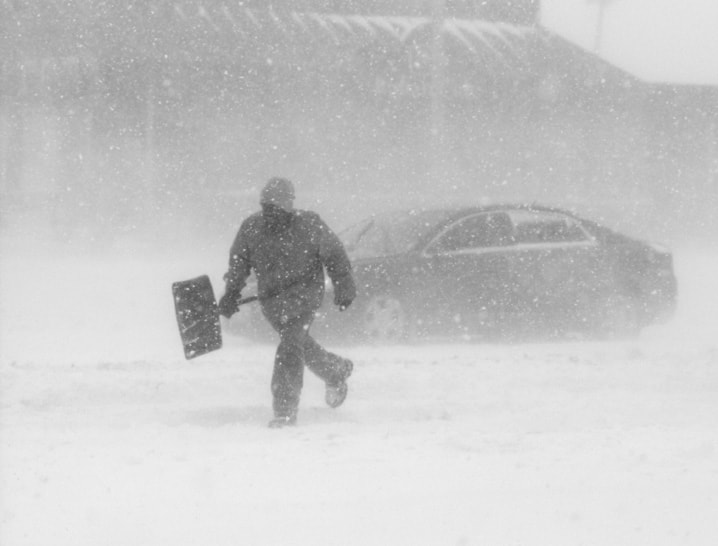CHICAGO — Snow-covered roads and high winds created treacherous driving Sunday from the Dakotas to Michigan and Missouri as residents braced for the next round of bad weather: dangerously cold temperatures that could break records across much of the U.S.
Temperatures were being suppressed by a “polar vortex,” a counterclockwise-rotating pool of cold, dense air that will affect more than half of the continental U.S. throughout Sunday and into Monday and Tuesday, with wind chill warnings stretching from Montana to Alabama.
The forecast is extreme: 25 below zero Fahrenheit (31 below zero Celsius) in Fargo, North Dakota, minus 31 F (minus 35 C) in International Falls, Minnesota, and 15 below F (26 below C) in Indianapolis and Chicago. Wind chills — what it feels like outside when high winds are factored into the temperature — could drop into the negative 50s and 60s.
Northeastern Montana was warned Sunday of wind chills up to 59 below zero F (51 below zero C).
“It’s just a dangerous cold,” National Weather Service meteorologist Butch Dye in Missouri said.
Several Midwestern states were walloped with up to a foot (30 centimetres) of new snow on Sunday. Five to 9 inches (12.5 to 22.5 centimetres) fell overnight in the Chicago area, while the St. Louis area had about a foot (30 centimetres) of snow and northern Indiana had at least 8 inches (20 centimetres. Central Illinois was bracing for 8 to 10 inches (20 to 25 centimetres), and southern Michigan could see up to 15 inches (37.5 centimetres).
Officials closed several Illinois roadways because of drifting snow, and warned residents to stay inside. Roads in the Midwest were particularly dangerous, and officials in Missouri warned it was too cold for rock salt to be very effective.
Authorities also urged residents to check on elderly and disabled relatives and neighbours.
In Chicago, temperatures were expected to bottom out around minus 15 F (minus 26 C) overnight, likely setting a daily record, National Weather Service meteorologist Ed Fenelon said. Earlier Sunday, temperatures sank to 20-below F (29-below C) and colder in northern Minnesota and Grand Forks, North Dakota.
In Wisconsin, Green Bay Packers fans packed Lambeau Field despite the dangerous cold for Sunday’s National Football League playoff game against the San Francisco 49ers. It could be among the coldest ever played: It was 5 degrees F (minus 15 degrees Celsius) at kickoff at 3:40 p.m. CST, warmer than expected.
“We suited up, we brought all the snowboarding gear we use ... and added to it,” said 49ers fan Jeff Giardinelli of Fresno California, as he walked across a parking lot with a friend. “Without the wind, which isn’t here yet, we’re good. When it gets windy, we’ll be ready for it.”
It hasn’t been this cold for almost two decades in many parts of the U.S. Frostbite and hypothermia can set in quickly at 15 to 30 below zero F (26 to 34.4 below zero C).
Lorna West, a 43-year-old student and consultant from Columbus, Ohio, said she doesn’t believe people unaccustomed to such weather are ready for what’s coming.
A Chicago native, she said thermal underwear, lots of layers and “Eskimo coats” with zipped hoods to block the wind were the norm growing up.
“And don’t go out if you don’t have to,” she said.
In St. Louis, grocery stores sold out of the essentials before Sunday’s weather onslaught.
“The problem is the bread is sold out. We’re out of milk. We sold out of chips, chicken wings, some meats,” Issa Arar of Salama Supermarket said.
Travel problems started early Sunday. In New York City, a plane from Toronto landed at Kennedy International Airport and then slid into snow on a taxiway. No one was hurt, though the airport temporarily suspended operations because of icy runways.
About 1,200 flights had been cancelled Sunday at O’Hare and Midway international airports in Chicago, aviation officials said, and there also were cancellations at Logan International Airport in Boston and Tennessee’s Memphis and Nashville international airports.
School was called off Monday for the entire state of Minnesota, as well as cities and districts in Wisconsin, Illinois, Indiana and Iowa, among others.
Southern states were bracing for possible record cold temperatures, too, with single-digit F highs (highs from minus 13 to minus 17 C)expected Tuesday in Georgia and Alabama.
Temperatures are expected to dip into the 30s F (single digits C) in parts of Florida on Tuesday. But Florida Citrus Mutual spokesman Andrew Meadows said it must be at 28 degrees F (minus 2 C) or lower four hours straight for fruit to freeze badly.
In western Kentucky, Smithland farmer David Nickell moved extra hay to the field and his animals out of the wind. He’d also stocked up on batteries and gas and loaded up the pantry and freezer.
The 2009 ice storm that paralyzed the state and knocked out power to hundreds of thousands of people is fresh in his mind.
“We are hoping this isn’t going to be more than a few days of cold weather, but we did learn with the ice storm that you can wake up in the 19th century and you need to be able to not only survive, but be comfortable and continue with your basic day-to-day functions,” Nickell said.
